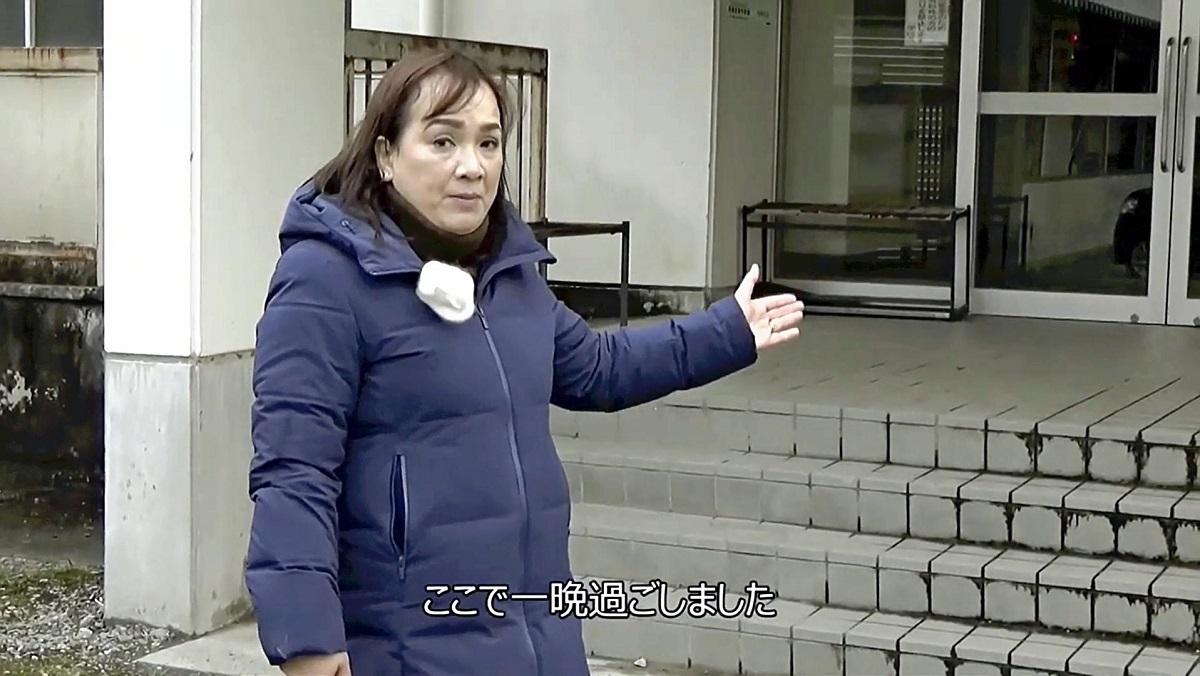Survivor Shares Quake Experience in Tagalog; Aichi Prefecture Government Produces Disaster Awareness Videos for Foreign Residents

Marife Sugawara appears in a video produced by the Aichi prefectural police to raise awareness of possible disasters.
12:31 JST, August 26, 2024
RIKUZENTAKATA, Iwate — Marife Sugawara, 59, a Filipina woman who lives in Rikuzentakata, Iwate Prefecture, shares her experience of the 2011 Great East Japan Earthquake in her native Tagalog in a video produced by the Aichi prefectural police to raise awareness of possible disasters among foreign residents.
In the video, which was uploaded to YouTube in June, Sugawara calls on viewers to participate in emergency drills and make advance preparations.
The police have also produced disaster awareness videos in Vietnamese, Spanish, Portuguese and Indonesian. The videos are designed to teach foreign residents about the risks of natural disasters, such as a potential Nankai Trough Earthquake, as well as wind and flood damage, and the importance of being prepared to mitigate the impact of such disasters.
They decided to produce a Tagalog version as well, because Filipinos are the fourth largest group of foreign residents in Aichi Prefecture, numbering 43,000 — more than in any other Japanese prefecture — as of June last year. Sugawara, who had already shared her experience of the disaster through such means as lectures, was chosen as the speaker.
Sugawara first came to Japan when she got married, about 30 years ago. When the 2011 quake occurred, she was working at a fish processing factory near the ocean in Rikuzentakata.
She went to pick up her sons, then a second-year student in junior high school and a sixth grader in elementary school, at their schools, which were on higher ground.
Although she planned to take them home, a teacher stopped her and told her, “Stay here if you want to live.” She did as she was told. Their house was washed away by the tsunami a little later.
In this approximately 15-minute video, Sugawara looks back on that time while walking the actual evacuation route they took to higher ground and giving advice on disaster preparedness for foreign residents.
Recalling the anxiety she felt when she did not understand disaster-related Japanese words at the time of the earthquake, she urges the viewers to learn some basic terms, such as “bochotei” (sea walls) and “hinan” (evacuation), that are used when disasters occur.
Sugawara was interviewed in Tagalog by staffers from the prefectural police’s International Police Affairs Center in January.
Explaining the reason for the interview, an official in charge said: “Most public information materials for foreigners are simply translations of existing Japanese materials. It is meaningful to have foreigners speak in their own language and explain the horror of natural disasters and the importance of making preparations.”
Sugawara said: “The video is not just for Filipinos. I want to convey the message to Japanese people as well that they should actively talk to any foreigners they encounter in the event of a disaster.”
"Society" POPULAR ARTICLE
-

M4.9 Earthquake Hits Tokyo, Neighboring Prefectures
-

M7.5 Earthquake Hits Northern Japan; Tsunami Waves Observed in Hokkaido, Aomori and Iwate Prefectures
-

Israeli Tourists Refused Accommodation at Hotel in Japan’s Nagano Pref., Prompting Protest by Israeli Embassy and Probe by Prefecture
-

Tsukiji Market Urges Tourists to Avoid Visiting in Year-End
-

M5.7 Earthquake Hits Japan’s Kumamoto Pref., Measuring Upper 5 Intensity, No Tsunami Expected
JN ACCESS RANKING
-

Keidanren Chairman Yoshinobu Tsutsui Visits Kashiwazaki-Kariwa Nuclear Power Plant; Inspects New Emergency Safety System
-

Imports of Rare Earths from China Facing Delays, May Be Caused by Deterioration of Japan-China Relations
-

University of Tokyo Professor Discusses Japanese Economic Security in Interview Ahead of Forum
-

Japan Pulls out of Vietnam Nuclear Project, Complicating Hanoi’s Power Plans
-

Govt Aims to Expand NISA Program Lineup, Abolish Age Restriction























